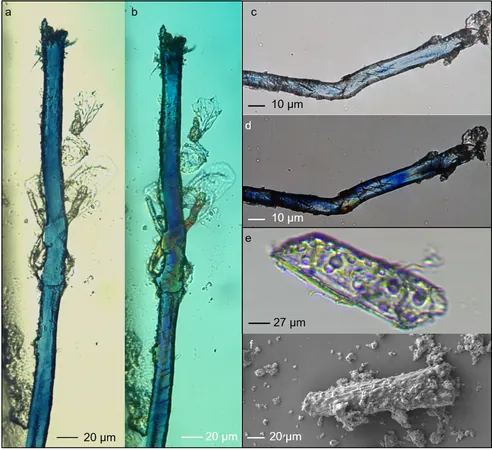
Ancient Blue: 34,000-Year-Old Grinding Tools Reveal Use of Indigo Dye
2025-09-02
Author: Amelia
Unearthing the Color of the Past
In a groundbreaking discovery, a global research team from Ca' Foscari University of Venice has revealed the presence of indigotin, a vibrant blue dye, on ancient stone tools that date back an astonishing 34,000 years. This indigo compound, derived from the woad plant (Isatis tinctoria L.), was found on grinding stones unearthed in the Dzudzuana Cave in the Caucasus region of Georgia.
A Revelation in Paleolithic Practices
This is the first time such an ancient artifact has shown evidence of dyed plant processing, indicating that early Homo sapiens were not just foragers of food but pioneers in complex resource utilization. According to archaeologist Laura Longo, this discovery shifts our understanding of how ancient peoples interacted with plants, suggesting sophisticated applications beyond mere sustenance.
The Science Behind the Indigo Discovery
Indigotins are formed through reactions involving atmospheric oxygen and glycosides in the leaves of the woad plant. This finding shows that even non-edible plants were deliberately cultivated and processed thousands of years ago, adding depth to our understanding of prehistoric life and culture.
Tools that Tell a Story
The research involved meticulous microscopic analyses of the stone tools, revealing mechanical processing marks compatible with plant materials. Astonishingly, they discovered blue residues alongside starch grains on worn areas of the tools. Advanced spectroscopic techniques confirmed these specters of the past to be indigo.
Unlocking New Mysteries: Medicinal or Dye?
With the presence of indigo established, new questions arise: How did these plant compounds become integrated into the daily life of Paleolithic people? To explore this, researchers examined the tools' porosity and held replicative experiments, processing plants similar to those used by prehistoric inhabitants. The findings reveal a sophisticated understanding of plant properties and their applications.
A Window into Prehistoric Ingenuity
Over three summers, researchers experimented with the woad plant, shedding light on how early humans likely harnessed its dye properties. The insights gathered from these innovative experiments not only enhance our understanding of early human behavior but also celebrate the ingenuity of those who lived thousands of years ago. What other secrets do ancient artifacts hold? The saga of human innovation continues to unfold.









 Brasil (PT)
Brasil (PT)
 Canada (EN)
Canada (EN)
 Chile (ES)
Chile (ES)
 Česko (CS)
Česko (CS)
 대한민국 (KO)
대한민국 (KO)
 España (ES)
España (ES)
 France (FR)
France (FR)
 Hong Kong (EN)
Hong Kong (EN)
 Italia (IT)
Italia (IT)
 日本 (JA)
日本 (JA)
 Magyarország (HU)
Magyarország (HU)
 Norge (NO)
Norge (NO)
 Polska (PL)
Polska (PL)
 Schweiz (DE)
Schweiz (DE)
 Singapore (EN)
Singapore (EN)
 Sverige (SV)
Sverige (SV)
 Suomi (FI)
Suomi (FI)
 Türkiye (TR)
Türkiye (TR)
 الإمارات العربية المتحدة (AR)
الإمارات العربية المتحدة (AR)